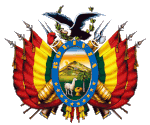Bolivia coat of arms
| Bolivia coat of arms | |
|---|---|

|
|
| Details | |
| Introduced | 2004 |
| Previous versions |
 (1825–1826) (1825–1826)  (1826–1888) (1826–1888)  (from 1888) (from 1888)
|
The coat of arms of Bolivia has been in use in this form since 2004, but has only changed slightly since 1888.
description
With government decree 27630 of July 19, 2004, some elements of the coat of arms were changed. At the same time, the meaning of symbolism was partially redefined.
There is an oval in the center of the coat of arms . In it is the Silver Mountain of Potosí , behind which the sun rises. They symbolize the mineral wealth of the country and the burgeoning splendor of the republic. On a hill in front of the Silberberg there is a small church, the Capilla del Sagrado Corazón de Jesus (before 2004: Casa de la Moneda (Potosí)).
In front of the mountain are a llama (before 2004: alpaca ), one of the national animals of Bolivia, a sheaf of wheat and a typical palm (before 2004: breadfruit ), which symbolize the flora and fauna of Bolivia as well as agricultural production.
The oval is outlined in blue (before 2004: gold and blue), which stands for the watercourses and the sea. In this border is in gold (before 2004: red ) the Spanish name Bolivia, Bolivia , while ten gold stars are shown below, which stand for the Bolivian departments , including the Región de Antofagasta , which was lost to Chile in 1879 , to which Bolivia as the Departamento Litoral still lays claim. The star for Litoral was never removed, while another nine stars were added to the coat of arms in 1963, which stands for the Department of Pando founded on September 24, 1938 by President Germán Busch Becerra .
Behind the oval described are two groups of three of the flag of Bolivia , two cannon barrels , two pairs of muskets , a battle ax and a red Phrygian cap . All of this symbolizes the will of the Bolivians to defend their homeland and their freedom. An Andean condor sits above the oval in front of a wreath of laurels and olive branches . This part stands for the audacity, courage, pride and love of freedom of the population as well as the triumphs, peace and integration of the republic.
The Bolivian national coat of arms is depicted in the national flag and in the country's war flag.
literature
- Karl-Heinz Hesmer: Flags and coats of arms of the world. History and symbolism of the flags and coats of arms of all states . Gütersloh: Bertelsmann Lexikon Verlag, 1992. ISBN 3-570-01082-1

